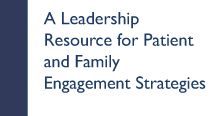A Leadership Resource for Patient and Family Engagement Strategies

Even if you know what patient and family engagement is how do you get started? This AHA resource "gives hospital and health system leaders concrete, practical steps grounded on evidence-based research to improve patient and family engagement in their organizations:"
Five Ways that Patient and Family Engagement Matters- assessing how well the organization is doing;
- identifying processes and systems to support patient engagement;
- ensuring staff obtain training for effectively using these systems and processes;
- intervening to overcome specific obstacles that may emerge; and
- monitoring progress toward achieving patient and family engagement goals.
- Contributes to better clinical outcomes (6)
- Reduces institutional and individual costs of care (7, 8)
- Increases adherence to recommended treatment regimens, which can lead to fewer complications and re-hospitalizations (9, 10, 11)
- Improves patient satisfaction with care coordination and other patient experience measures that impact the hospital’s reimbursement rates from Medicare and other payers (12, 13)
- Enables compliance with patient engagement requirements included in HITEC meaningful use and patient-centered medical home payment models (14)
via http://www.hpoe.org/resources/hpoehretaha-guides/1407
Sources
6. Weingart SN, Zhu J, Chiapetta L, et al. Hospitalized patients’ participation and its impact on quality of care and patientsafety. International Journal for Quality in Health Care. 2011;23(3):269-77.
7. Hibbard JH, Greene J, Overton V. Patients with lower activation associated with higher costs: Delivery systems should know
their patients’ “scores.” Health Affairs. 2013;32(2)216-22.
8. Institute of Medicine. Demanding value from our health care: motivating patient action to reduce waste in health care.
Washington, D.C.: National Academies Press, 2012.
9. Hibbard JH, Mahoney ER, Stock R, et al., op. cit.
10. McCarly P. Patient empowerment and motivational interviewing: Engaging patients to self-manage their own care.
Nephrology Nursing Journal. 2009;36(4):409-14.
11. Judson TJ, Detsky AS, Press MJ. Encouraging patients to ask questions: How to overcome “white-coat silence.” Journal of
the American Medical Association. 2013;309)22): 2325-6.
12. Sorra J, Khanna K, Dyer N, et al. Exploring relationships between patient safety culture and patients’ assessments of
hospital care. Journal of Patient Satisfaction. 2012;8(3):1-9.
13. Weingart SN, Zhu J, Chiapetta L, et al. Hospitalized patients’ participation and its impact on quality of care and patient
safety. International Journal for Quality in Health Care. 2011;23(3):269-77.
14. McGraw D. Meeting Patient Engagement Objectives of Meaningful Use Stage 2: Credentialing Patients. HealthITBuzz, U.S.
Department of Health & Human Services, 2012. Available at: http://www.healthit.gov/buzz-blog/meaningful-use/patient-engagement-objectives-meaningful-stage-2/ (Accessed July 3, 2013)
No comments:
Post a Comment